Coffee Map | You may not guess that Vietnam is the second largest coffee producer in the world
When we think of Asian coffee, we probably think of Indonesia, Yunnan, Taiwan or even Japan. Rarely do we mention around Southeast Asia. Maybe nowadays, boutique coffee is so popular that the origin of non-Arabica coffee is ignored.
But as the second most productive tree species in the coffee world, Robusta has been scientifically labeled as a poor quality coffee, difficult to drink, instant ingredient, etc. While some of this is true, I want you to use this article to get a clearer understanding of Robusta as a bean species. And to understand Robusta, we need to start with Vietnam, the second largest coffee producing country in the world, as 80% of their production is Robusta.
Robusta
Robusta species, probably consumers do not have many opportunities to directly contact, or even directly drink it, so before getting to know Vietnamese coffee, it is better to systematically know Robusta.
We often use Robusta to compare with Arabica. In fact, this is not strict, because the two are not even in the same class botanically. Robusta belongs to the Canephora species, also known as the Congo species and medium-fruited coffee. This is similar to Typica which belongs to the Arabica species. However, only one of the Canephora species, Robusta, is known commercially, and Robusta has now almost replaced Canephora as the synonym for this lineage.
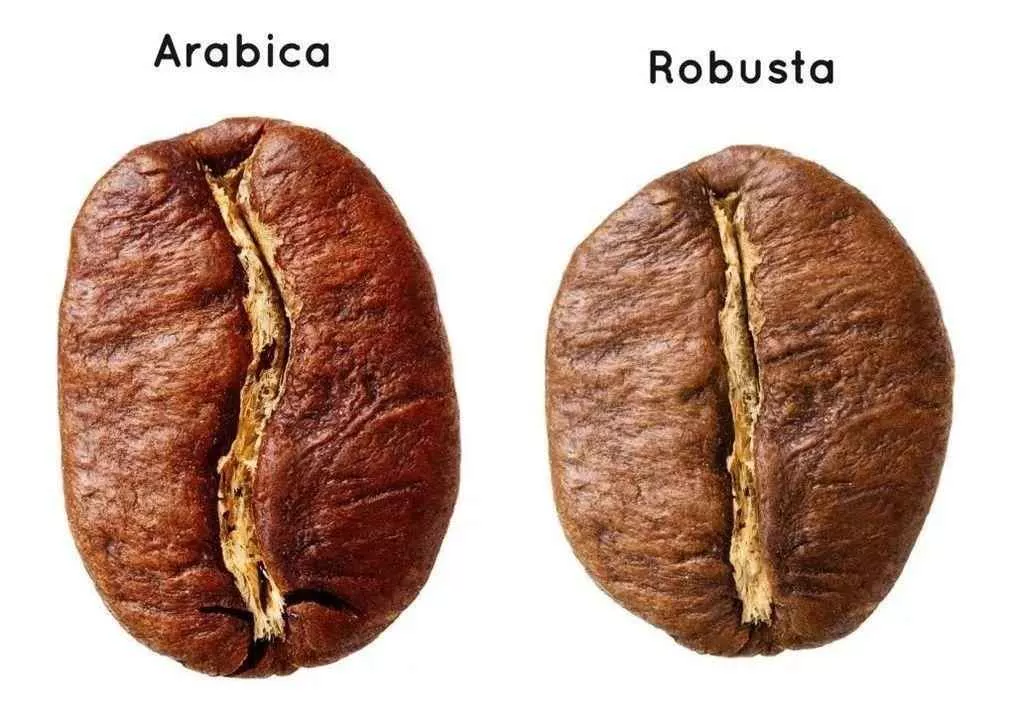
Currently the main sources are Vietnam, Uganda, Brazil, India, Hainan, China (in small quantities), etc. It accounts for about 30% of the world's total production.
Robusta is high yielding, full-bodied, more bitter, high in caffeine (1.7% to 3.0%) and inexpensive; therefore, it was used heavily in the first and second waves for the vast majority of instant and blended coffees.

The Robusta coffee tree is a species between a shrub and a tall tree with long leaves and a bright green color, wild coffee trees reach up to 10 m. When used commercially, they need to be pruned to a height of about 5 m for harvesting. The roots are shallow, however, and the fruit is slightly rounder and smaller than that of Arabica coffee, with a flat, round body and a straight central pit. It can be planted at altitudes of up to 800 m. It is extremely adaptable to the environment and has a high resistance to pests and diseases.
It can withstand high temperatures (above 30°C) and full sun. It likes to stay hydrated and needs lots of water to be happy and healthy.
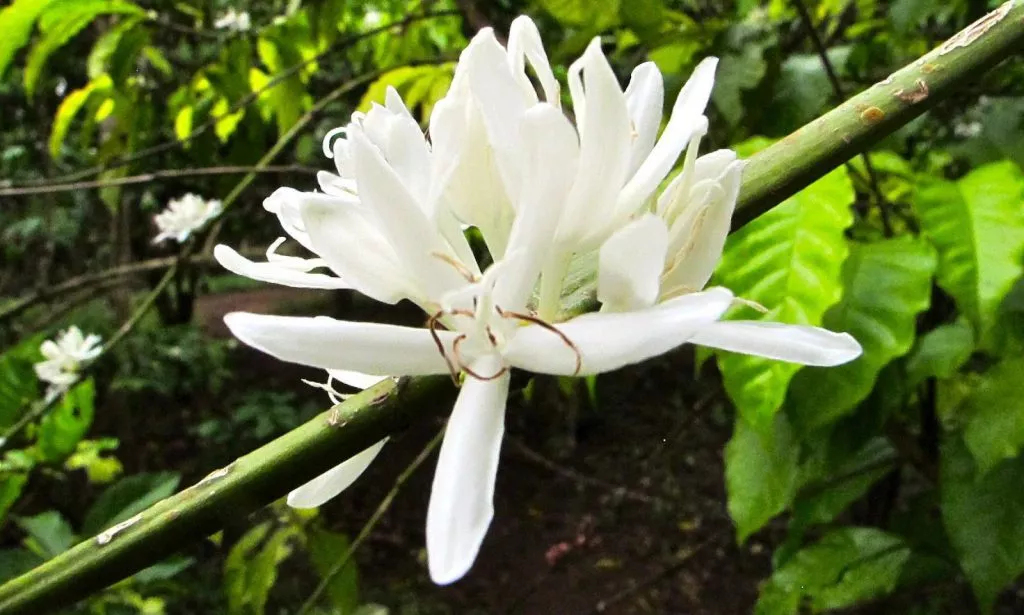
The coffee flowers of Robusta in the central region of Uganda are white and have a lightly sweet aroma like jasmine. Robusta is pollinated by insects or wind; it takes about 9-11 months from pollination to fruiting, which is relatively short compared to Arabica.
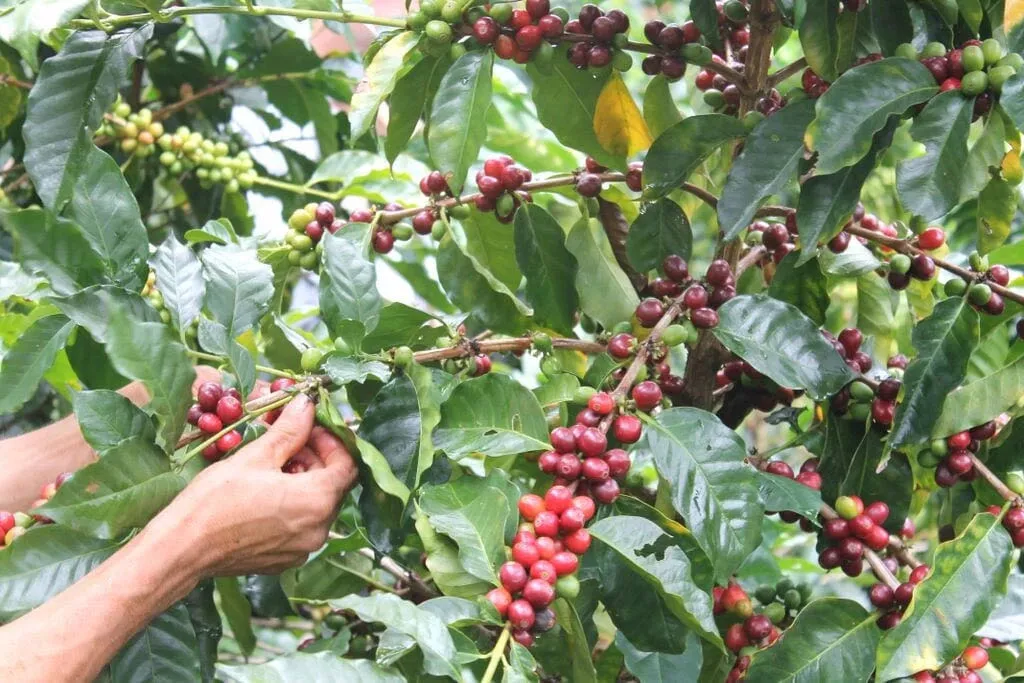
Compared to Arabica coffee, Robusta is higher in caffeine, amino acids and chlorogenic acid. Of these, caffeine and chlorogenic acid are the source of the bitterness and contain half the sugar of Arabica, so Robusta's flavor is not as attractive and elegant as Arabica, instead it has a mellower, more subdued taste and a predominance of walnut, peanut, hazelnut, wheat, and grain flavors, even to the point of a harsh earthiness.
It is used to make instant coffee or espresso blends because of its high yield, fast maturation and low management costs.
Boutique Robusta
Many of you may know that Arabica is the term for fine coffee, but you don't know that Robusta is also a fine coffee. For those of you who know more about coffee, you may have heard of the CQI (Coffee Quality Institute) organization.

CQI was established in 1996 and the Q program courses have been open since 2003.Q-graders have to renew their certificates every 3 years to In 2009, CQI organized a workshop on Robusta. 2010, Q Robusta, in collaboration with the Uganda Coffee Development Authority (UCDA), organized the first course in Uganda specializing in the evaluation and grading of fine Robusta coffee.
The evaluation system is basically the same as that of Arabica, starting with raw beans, which are fully compliant with the SCA raw bean standard. See also.
We will focus on the dimensions of the CQI for the Robusta Cup test.
- Roast level: Agtron bean surface color value 48; coffee powder color value 78 (±1).
- Fragrance/Aroma (Fragrance/Aroma): dry fragrance (smell of ground coffee), wet fragrance (smell after steeping)
- Flavor
- Sense of Balance (Balance)
- Holistic (Overall)
- Aftertaste: For this item, there are 2 options
- Slightly salty aftertaste (unpleasant salty taste)
- Savoury (salty feel)
- Fullness (Body): this is not available in the Robusta rating. This is because it is known for its high mellowness itself.
- Salt/Acid Ratio: This evaluation dimension, used in place of acidity, has a salt to acid ratio of 1:6. CQI believes that because Robusta has a lot of potassium, which creates a certain level of salinity in the coffee, the cup test is correct in responding to the salty taste. This is not a flaw. 'Fine Robusta' is considered to have a lower salinity and higher acidity. The lower the perceived salinity, the higher the 'salt' score. The higher the acidity, the higher the acidity score. The total salt/acid ratio score is 10. (For example, you can only have salt 5 + acid 5 = total 10; you cannot have salt 6 + acid 5 = total 11).
- Bitter/Sweet Ratio: The ratio of bitter/sweet is also 1:6. The total score should not exceed 10 points because 'Fine Robusta' is always considered to have a certain bitterness. The more bitter the taste, the higher the score, and high sweetness means a high score.
- Mouthfeel (Mouthfeel): divided into rough (taking a sip of coffee with coffee grounds) touch and smooth touch.
This is the Robusta Cup measurement table for reference.

Fine Robusta Cupping Form In addition to the bonus points, of course, there are corresponding minus points, such as drinking defective flavors, or test samples that are faulty will also be deducted. If the final total score is greater than 90, it is considered "Very Fine Robusta". 80-90 points are "Fine Robusta". 70-80 points are "Premium Robusta".
Basic information on Viet Nam
The Socialist Republic of Vietnam (Vietnamese: Cộng hòa xã hội chủ nghĩa Việt Nam) is commonly known as Vietnam (Vietnamese: Việt Nam). Vietnam is a multi-ethnic socialist traditional agricultural country in Asia with a predominantly Kinh ethnic group. It is located in the eastern part of the south-central peninsula of Southeast Asia, bordering Guangxi and Yunnan of China in the north and Laos and Cambodia in the west. It has a long and narrow land area of about 330,000 square kilometres and is close to the South China Sea with a coastline of more than 3,260 kilometres. The agricultural population accounts for about 70% of the total population. Arable land and forest land account for 55 per cent of the total area.
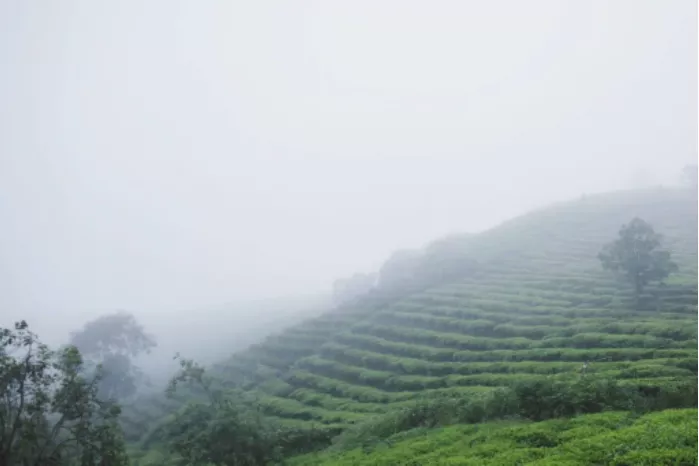
Vietnam is located in Southeast Asia and has a tropical subtropical climate. The climate is divided into three major zones: humid northern subtropical climate, south-central tropical monsoon climate, and south-central savanna. Annual rainfall varies from 1,500 mm to 2,000 mm, and temperatures range from 5 degrees Celsius from December to January and around 37 degrees Celsius from April to May each year. The seasonal divisions are more pronounced in the northern part of the country than in the south.
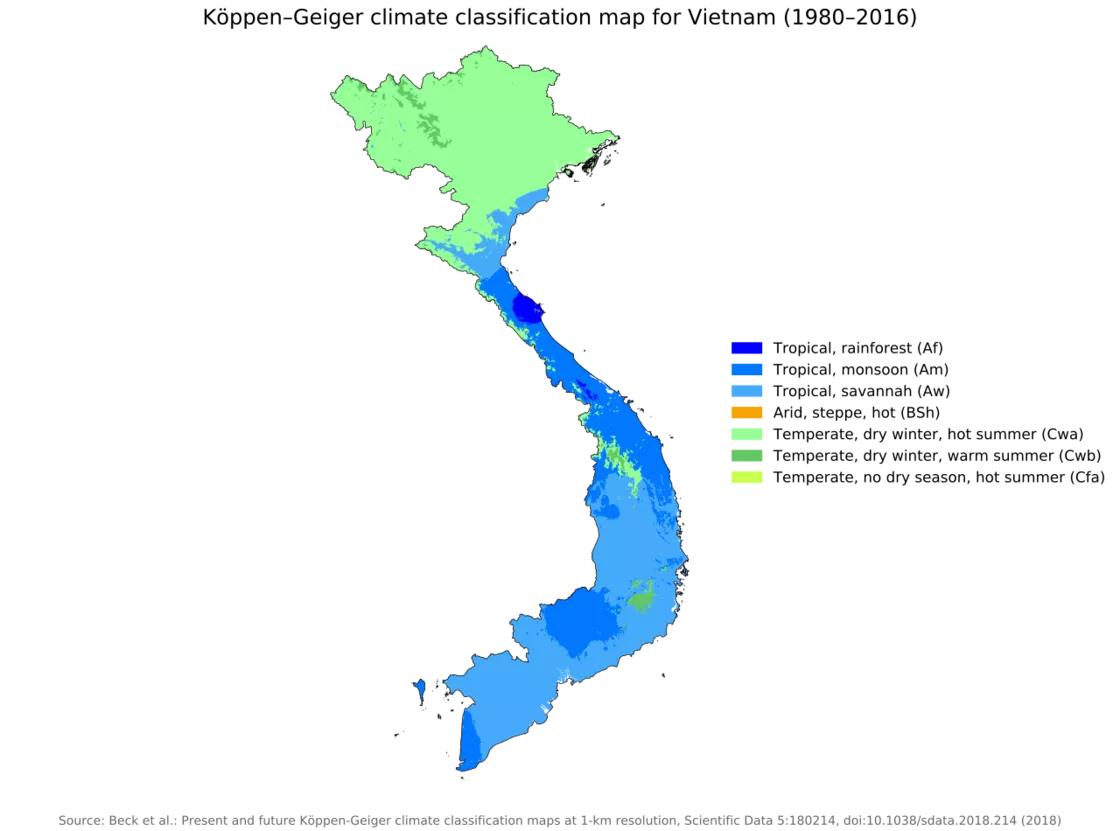
Vietnam Climate Classification Map 1980-2016 Vietnam's geographical location and natural conditions are very conducive to agricultural activities, producing rice, tropical crops and fishery products, and is a major exporter of agricultural products in Southeast Asia, Vietnam is the world's top processor and exporter of cashew nuts, accounting for about 80% of the world's cashew nut exports, the world's second largest exporter of rice, the world's second largest exporter of coffee, and the largest exporter of Robusta coffee.
Coffee History
According to 2020 statistics, Vietnam became the second largest coffee exporter in the world with 1.7 million tons of production, accounting for 17.1% of the world coffee market shipments. The production of Robusta coffee beans accounts for more than 40% of the world's total production, and it surpasses Brazil (25%), Indonesia (13%), India (5%) and Uganda (5%).
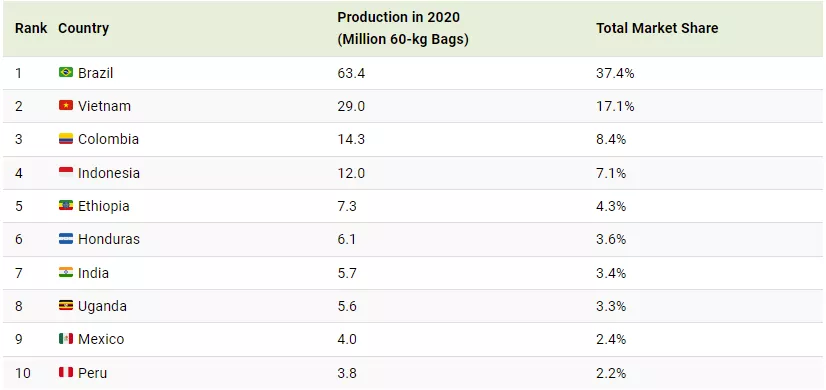
Coffee in Vietnam, too, has taken decades to develop to its current size. Vietnamese coffee was first brought to Vietnam by the French in 1857. And it is mentioned in the book "Vietnam: The Lost Word of World History" that France introduced it in 1888 AD and planted it for production in Hanoi. This was followed by a gradual expansion to other highland areas.

When coffee was first introduced to Vietnam, it did not flourish immediately. It was not until around 1910 or 1911 that coffee began to be grown in different regions for commercial purposes. After the reunification of Vietnam in 1975, the Vietnamese government's policy of building a "new economic zone" led to a large migration of people to the central highlands, which provided a population base for coffee production. In the early 1980s, medium-grain coffee (Robusta) was chosen as the main variety. The planting techniques were adapted to the local conditions with high density planting, heavy irrigation, excessive fertilization, and no shade trees to obtain maximum yields. In some plantations, yields could even be as high as about 5 tons/ha.
In 1986, the Vietnamese government carried out reforms and since then, Vietnam's coffee production has increased dramatically. 1988, Vietnam has become the fourth largest coffee exporter in the world, accounting for about 6.5% of the world total. Today, Vietnam is the second largest exporter of coffee in the world and the first exporter of Robusta coffee in the world.
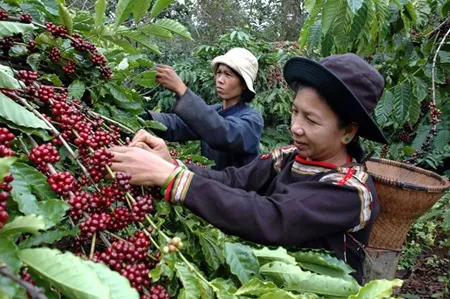
The coffee industry in Viet Nam supports about 600,000 farmers and millions of people are associated with the industry. The coffee industry absorbs about 2 per cent of the country's total labour force. By 2010, Latin America's dominance of the international coffee market was being seriously challenged by Asian countries.
Due to global warming, many places where Arabica would have been grown cannot continue to do so because the weather is too hot, but Robusta can survive in hot climates and with good disease resistance and high yields, Vietnam has the advantageous conditions to become an industrial coffee country.
Coffee growing
Arabica is grown in high altitude mountainous areas where the temperature is 20°C-22°C and the annual rainfall is 1300-1900 mm. Robusta is grown in the highlands and plains where the climate is hot, with high humidity, little direct sunlight and temperatures between 24°C and 26°C. Therefore, the south of Vietnam is suitable for Robusta coffee and the north is suitable for Arabica coffee. Therefore, the south of Vietnam is suitable for Robusta coffee and the north is suitable for Arabica coffee.
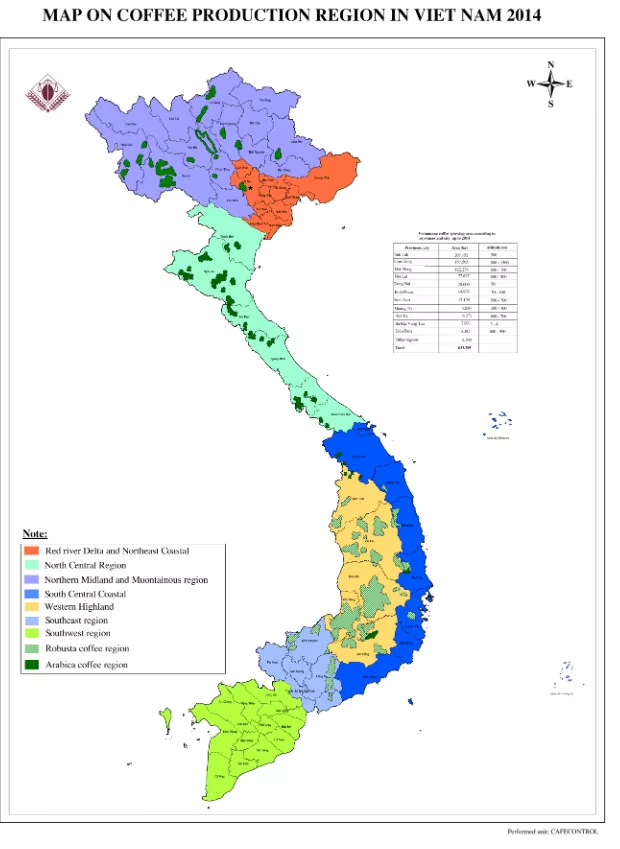
Map of coffee-producing areas (2014) Robusta in four provinces of the Central Highlands : Dak Lak, Lindong, Dak Nong and Jalai, with a total area under cultivation of 540,000 ha and about 70,000 ha in other provinces.
Arabica is found in central areas including Sura (northwestern Vietnam), Ngan, Quang Tri (central provinces) and Lang Dong (central highlands), as well as a number of other central areas suitable for Arabica varieties.
Coffee producing areas
The area under coffee cultivation in Viet Nam is about 600,000 hectares, 5 per cent of which belongs to State-owned enterprises and farms and 95 per cent to individual farmers and estate owners. The estates are small, usually 2-5 hectares, with a small number of large estates of about 30-50 hectares. State-owned farms are also gradually being redistributed to small farmers.
Each year, about 300,000 farmers in Viet Nam are engaged in coffee cultivation, with a labour force of 600,000 people, which can reach 700,000 to 800,000 during the three months of the harvest period, thus absorbing 1.83 per cent of the total labour force and 2.93 per cent of the total agricultural labour force in Viet Nam.
In Vietnam, there are specialized farms that deal with only one crop. There are also integrated farms with a variety of agricultural products. In addition, there are two main types of integrated farms.
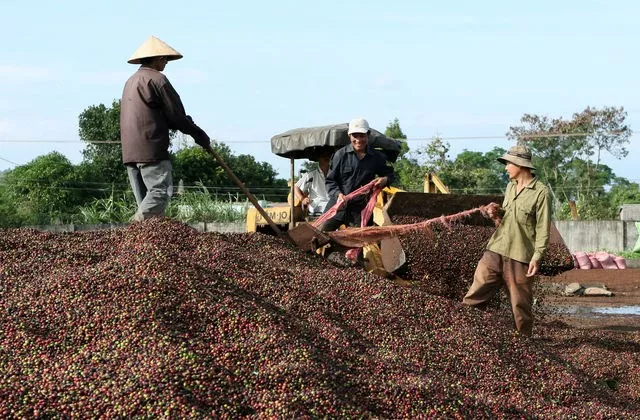
- The first type is a farm where different crops are shared or co-planted on the same piece of land. This is known as a synchronous farming system, which means intercropping coffee trees with other industrial crops.
- The second is to grow different crops on separate plots of land. This is known as segregated farming systems.
The planting density of Arabica varies according to the growing environment, soil properties and slope. It generally ranges from 2660 to 6660 trees per hectare. Robusta coffee, on the other hand, generally has about 1,330 trees per hectare.
The planting of coffee trees usually starts during the rainy season and stops at the end of the rainy season. Although it is the rainy season, it is still important to get enough water during the planting process.
Coffee trees are more wind-shy and also need shade. So it is important to plant both shade and wind protection plants. The shade trees should not be too dense and should be at a height of 2-4 meters above the top of the coffee tree so that the coffee tree below can receive sunlight.
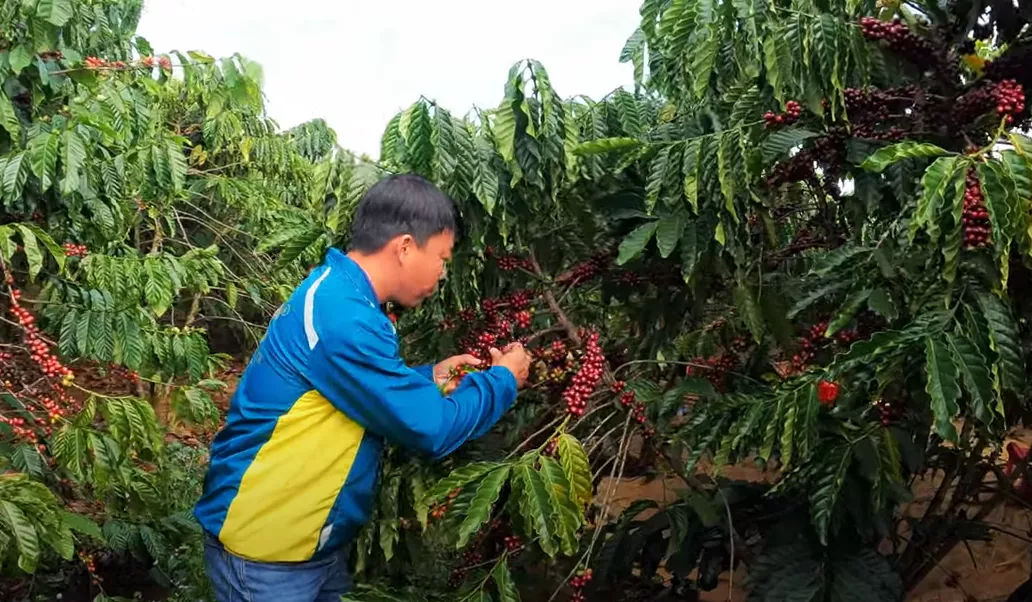
Shade and windbreak trees are planted to protect coffee trees, but also to stabilize the income of coffee farmers. After a period of planting trials, the Ministry of Agriculture and Rural Development introduced intercroppable varieties such as: pepper, fruit trees, avocado (avocado), durian and nuts.
To date, Vietnam has developed over 100,000 diversified farms, mainly in the Central Highlands.
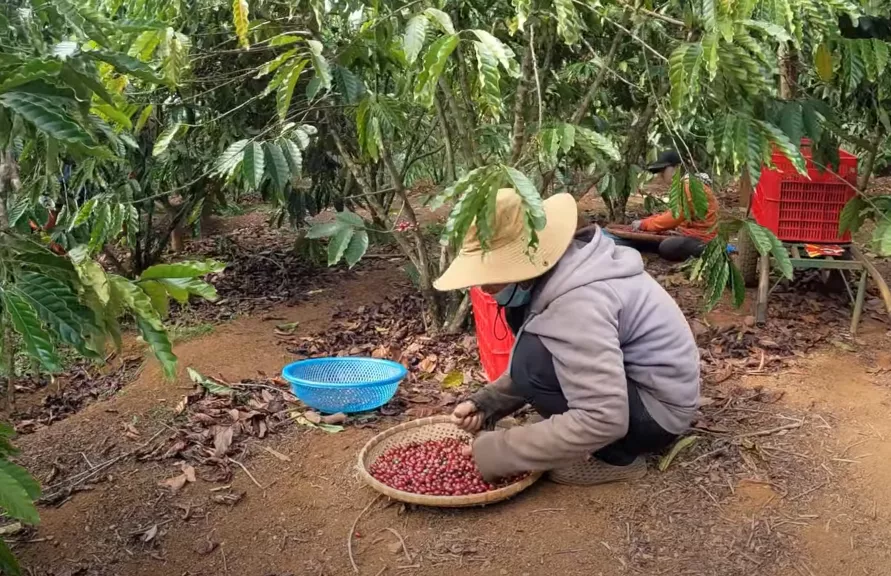
In an effort to limit the expansion of coffee areas and increase the quality, quantity and income from coffee production, the Vietnamese government has developed a review and reclassification master plan for the country's coffee areas, replacing old coffee trees with new varieties or promoting the planting of other crops in areas unsuitable for coffee cultivation.
treatment method
Raw bean processing in Vietnam is generally divided into Dry Processing and Wet Processing, which directly translates to dry processing and wet processing.
Dry processing (Dry Processing)
The dry process, in my opinion after comparing many sources, is the traditional sun drying method (Natural). In addition to the traditional solarization on a tanning bed, there is also the option of drying the coffee in a dryer. Both of these methods are designed to dry the raw coffee beans. Less water is used, hence the name dry processing.
Wet Processing (Wet Processing)
The wet process, after comparing many sources, is considered to be the washed process (Washed). However, unlike the regular washed process, it requires specific equipment and a large amount of water. The raw coffee produced in this way is usually of better quality and more expensive. There are two methods and they include.
Full-Wash (Full-Wash)
In a full water wash, use a manual or electric beater with water to physically remove the skin from the coffee cherries. Allow the sugar coating (mucilage) to ferment for a day or two, then wash the parchment thoroughly to remove all traces of fermented mucilage.
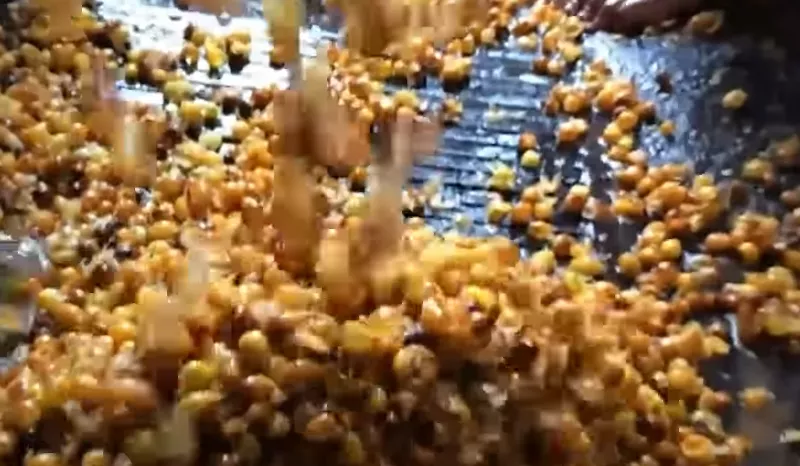
The parchment is dried until the beans inside have a moisture content of 12-13%. This process produces high quality coffee, but requires a lot of water - 2-10L/kg of water for fresh coffee cherries - and requires very good management of the fermentation and washing process to ensure that the coffee flavour is not compromised during the process.
Semi-wash (Semi-wash)
The semi-wash is the same process as the full-wash, where the peel of the coffee cherries is physically removed by a water-filled pulper. A slime remover is then used to remove the slime immediately after pulp making.
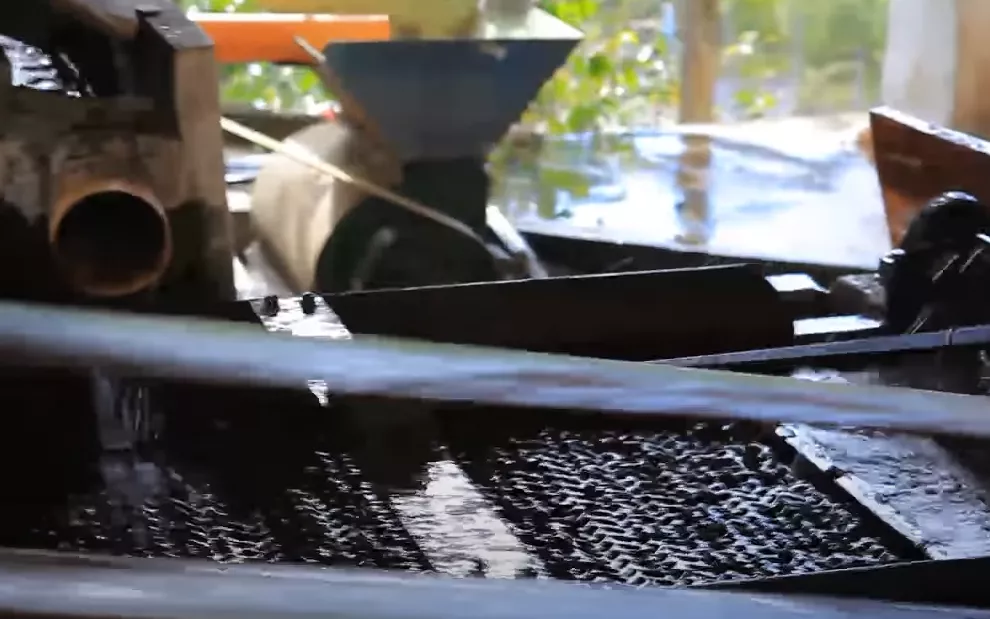
It is worth noting that the process does not ferment mucilage, as it is mechanically removed by a mucilage remover. After the mucilage is removed, the parchment layer is left and needs to be dried immediately until the moisture content of the beans inside reaches 12-13%.
The latest technology has shown that pulper and slime removal units are a cost-effective and efficient way to consistently produce high-quality coffee without fermentation and cleaning. These units typically use less water (about 0.5 liters of water per kilogram of coffee cherry) and reduce the risk of over-fermentation and quality problems in the final coffee product.
Parchment must be properly dried to avoid mould growth and contamination in order to achieve good quality, a process that takes 10-15 days until the moisture content reaches 12-13%.
Grading of raw beans
Improving the quality of Vietnamese coffee exports is one of the main objectives of the development strategy of the Vietnamese coffee industry. More than 90 per cent of the coffee produced in Viet Nam is exported. However, many traders and importers consider the quality of Vietnamese Robusta coffee to be relatively poor. Although Vietnam's Arabica is of higher quality, exports of Arabica account for only 3-4% of total exports. This has led to the creation of this standard, which is in line with international standards.
In February 2002, the International Coffee Agency (ICO) launched a new global Coffee Quality Improvement Programme (CQP), which came into effect on 1 October 2002. This was defined by the 85th International Coffee Council (ICC) meeting, Resolution 407. Resolution 407 establishes minimum standards and maximum grades for coffee exports from ICO members. Vietnam is a member of the ICO.
The standard is currently called: Vietnam Standards (TCVN 4193:2001) - Third revision
The entire standards document is designed to be very rigorous and complex, and it is not necessary for us lay people to understand it as 'academic' as it is. For those who are interested, check out "Reference 6". Here I will give you the most important grading criteria.
The grading of raw beans in Vietnam, as simply understood, is based on the number of flaws contained in 300g of raw coffee beans.
Grade
permissible per 300g of raw coffee beans
Total number of defects
Minimum weight ratio of round hole screens ArabicaRobustaArabicaRobusta ratio (%)Special grade1530No.18/No.16No.18/No.1690/10Grade 13060No.16/ No.14No.16/No.12 ½90/10Grade 26090No.12 ½/No.12No.12 ½/No.1290/10Grade 3120150No.12/No.10No.12/No.1090/10Grade 4150250///UnspecifiedGrade 5UnspecifiedUnspecified/ /UnspecifiedNo matter what the coffee is, the common grading standard cannot be separated from the sieve thing, and the same is true for Vietnamese grading, where the sieve looks like this.
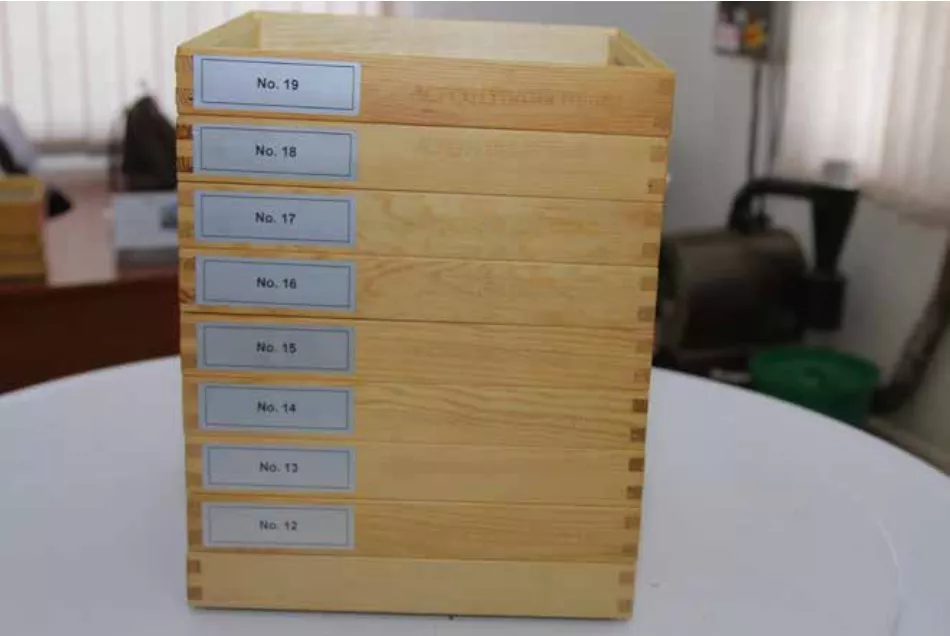
The screen grades in Vietnam are as follows.
Screen mesh Aperture (mm)No.104.00No.124.75No.12½5.00No.145.60No.156.00No.166.30No.176.70No.187.10No.197.50No.208.00Note: No.12½ sieve, equivalent to standard sieve No.13. according to standard: ISO 4150:1980
Generally on the market, the common Vietnamese Robusta is basically a G1 with a water wash bias. Interested parties can give it a try.
Coffee Organization
Bommysho Coffee Commodity Exchange (BCCE)
The Buon Ma Thuot Coffee and Commodity Exchange (BCCE) began operations on 10 March 2015 and will trade coffee.The BCCE, formerly known as the Buon Ma Thuot Coffee Exchange, has a total charter capital of VND75.5 billion (US$3.5 million), of which 42% comes from the Dak Lak Provincial People's Committee.
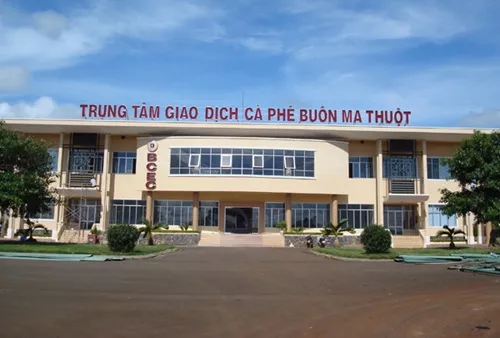
The exchange will trade two products: spot and futures on Robusta coffee, and will be linked to global commodity exchanges such as the Chicago Mercantile exchange) and other global commodity exchanges.
Vietnamese Coffee and Cocoa Association (vicofa)
The association has more than 100 members, including a number of state-owned enterprises, 18 private companies, 16 large farms in the Central Highlands, 26 foreign direct investment companies, four joint commercial banks, a commodity stock exchange and a scientific institute (Wasi). vicofa was founded in 1990 and became a member of the International Coffee Organization (ICO) in 1991. The objective is to organize the coffee industry and to assist governments in developing coffee policy. It is an independent business association, but is really more of a government-affiliated organization representing Vietnam in international and regional overseas forums, funded by its members and the government.
Vietnam Coffee Company (Vinacafe)
Vinacafe, a state-owned enterprise under the Ministry of Agriculture and Rural Development (MARD) of the Socialist Republic of Vietnam, manages 59 state-owned enterprises covering a range of sectors, including 40 state-owned farms with a total area of 27,000 hectares of coffee. These state farms work with 27 SOEs, including processors, traders and service providers that provide credit, fertilizer, irrigation, research and roasting services.
lastly
Vietnamese coffee, was the most difficult of the three to write about. This is because Robusta has not been a product sought after by the mainstream market. While overall production is not bad, not many people pay attention to it. So a lot of information is not good to look up. But finally, after comparing multiple sources, a relatively detailed overall introduction to Robusta coffee has been put together for now.
I hope this has helped you understand Robusta coffee, and if you're interested, you could even buy some and try it out?